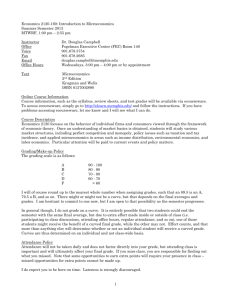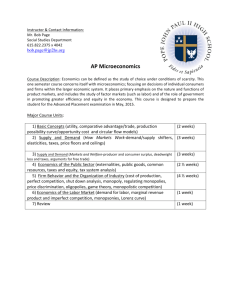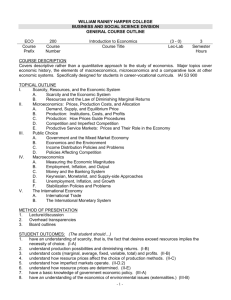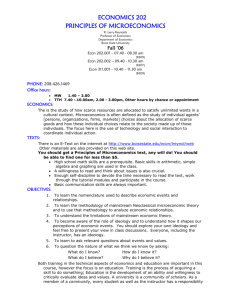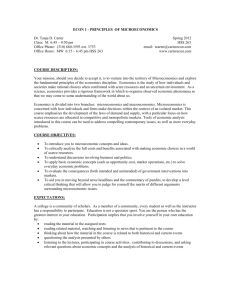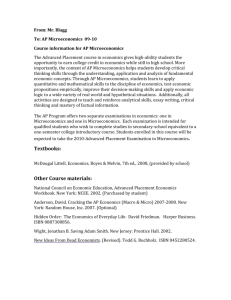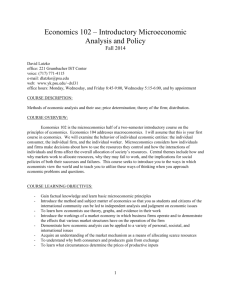Melrose High School Syllabus Department: Social Studies Course
advertisement
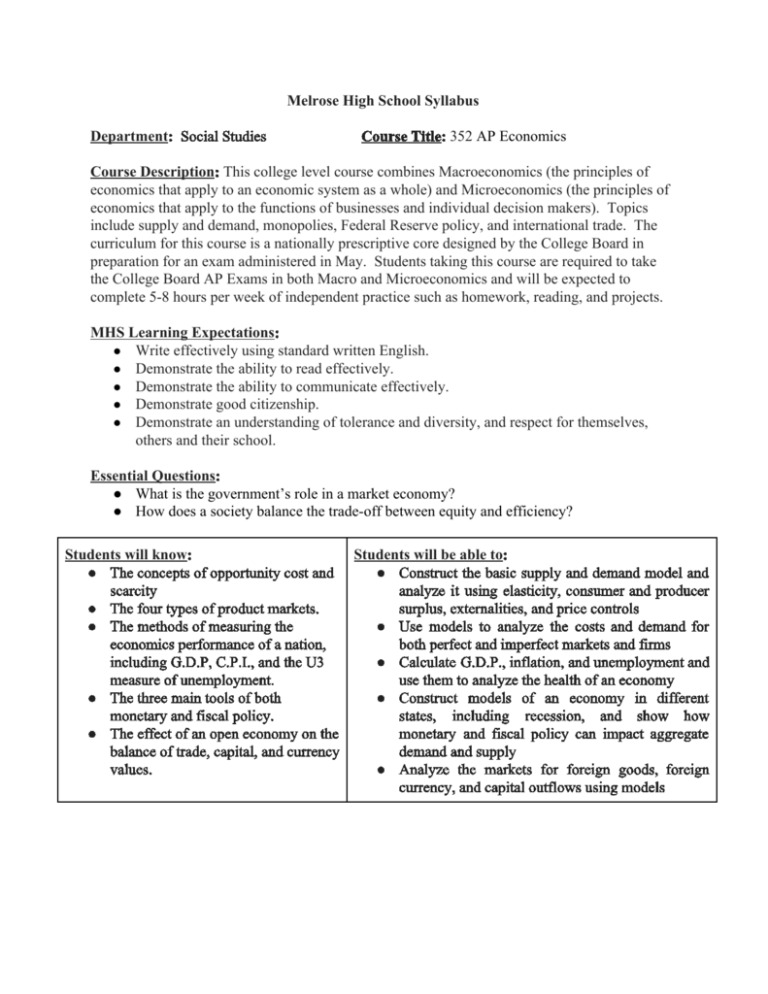
Melrose High School Syllabus Course Title : 352 AP Economics Department : Social Studies Course Description : This college level course combines Macroeconomics (the principles of economics that apply to an economic system as a whole) and Microeconomics (the principles of economics that apply to the functions of businesses and individual decision makers). Topics include supply and demand, monopolies, Federal Reserve policy, and international trade. The curriculum for this course is a nationally prescriptive core designed by the College Board in preparation for an exam administered in May. Students taking this course are required to take the College Board AP Exams in both Macro and Microeconomics and will be expected to complete 5­8 hours per week of independent practice such as homework, reading, and projects. MHS Learning Expectations : ● Write effectively using standard written English. ● Demonstrate the ability to read effectively. ● Demonstrate the ability to communicate effectively. ● Demonstrate good citizenship. ● Demonstrate an understanding of tolerance and diversity, and respect for themselves, others and their school. Essential Questions : ● What is the government’s role in a market economy? ● How does a society balance the trade­off between equity and efficiency? Students will know : Students will be able to : ● The concepts of opportunity cost and ● Construct the basic supply and demand model and scarcity analyze it using elasticity, consumer and producer ● The four types of product markets. surplus, externalities, and price controls ● The methods of measuring the ● Use models to analyze the costs and demand for economics performance of a nation, both perfect and imperfect markets and firms including G.D.P, C.P.I., and the U3 ● Calculate G.D.P., inflation, and unemployment and measure of unemployment. use them to analyze the health of an economy ● The three main tools of both ● Construct models of an economy in different monetary and fiscal policy. states, including recession, and show how ● The effect of an open economy on the monetary and fiscal policy can impact aggregate balance of trade, capital, and currency demand and supply values. ● Analyze the markets for foreign goods, foreign currency, and capital outflows using models Course Outline : Microeconomics ● ● ● ● ● ● ● ● ● Economic Models: Circular Flow and Production Possibilities, and Comparative Advantage Supply and Demand: The Basics Supply and Demand: Elasticity, Price Controls, Consumer Surplus, International Trade and Taxes Consumer Choice: Utility and Thinking at the Margin Costs of Production Perfect Competition & Imperfect Competition: Monopolies Imperfect Competition: Oligopolies, Game Theory, and Monopolistic Competition Market for Factors of Production: Labor Markets and Income Distribution Market Failure: Externalities and Public Goods Macroeconomics ● Measurement of Economic Performance & Growth: GDP, Inflation, and Unemployment ● Introduction to Aggregate Supply & Demand ● Financial Sector: Money and Banking ● Monetary Policy and Fiscal Policy ● Open Market Economics: Loanable Funds, Exchange Rates, and Capital Outflow & The Phillips Curve Primary Course Materials : Textbook: Ray and Anderson, Krugman’s Economics for AP Other materials: supplementary sources; relevant reference databases and websites such as Reffonomics and Khan Academy, and the e­book for the textbook, which can be accessed at: http://ebooks.bfwpub.com/krugman_ap_econ.php , Student Materials: notebook dedicated solely to AP Economics, with a folder or three­ring binder to save classwork/homework/handouts. Grade Determination : 10%­ Participation : scored 2­3 times per quarter on a participation rubric. 30%­ Projects/Homework/Do Nows: Homework will be assigned 2­3 times per week. Assignments will be listed on an assignment sheet. Grade will be based on homework worksheets & quizzes (10pts): collected on a random basis. Projects will be assigned 1­2 times per semester (20­200pts.). Do Nows (5pts): collected on a random basis. 60%­ Quizzes : 20%: Free Response Questions; 40%: Multiple Choice Questions Major Assignments : The major assignments for this course include : 13 unit exams, four projects, and a midyear and final exam. Midyear & Final Exams : Midyear and Final Exams will be given. These exams count as 10% of the respective semester grade. The average of the first and second quarter grades will count 90% in determining the first semester average. Similarly, the second semester average will include the average of third and fourth quarter grades at 90% and final exam at 10%. The average for the entire year will be the average of both semesters. Senior students will be asked to complete a final assessment at the end of both the third and fourth quarter. Q1 = 22.5% Q2 = 22.5% Midterm = 5% Q3 = 22.5% Q4 = 22.5% Final = 5%
